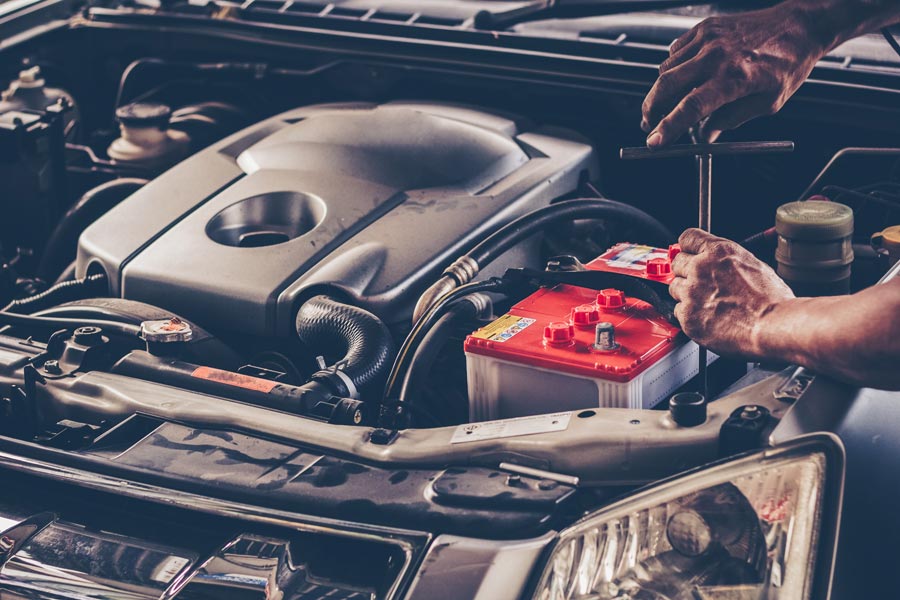Without them, no vehicle would get moving - the starter battery. It supplies the electrical power for the starter, must store energy and supply electrical consumers with power. Other battery types have also become established in addition to the standard lead-acid battery. But how do these differ exactly, when is each type used and what do the parameters actually mean on my battery?
What starter batteries are there?
The most common battery is and remains the lead-acid battery.
This battery type consists of six cells which are made up of positive and negative electrodes. Positive electrodes are made of lead oxide, while negative electrodes are made from pure lead. To ensure that the positive and negative poles do not touch directly and cause a short circuit, the electrodes are placed in bags that act as separators. The cells of the lead-acid battery are connected in series. This means that the negative pole leads one of the outer cells to the outside, while the positive pole of the same cell is connected to the negative pole of the next cell. All cells are connected together until the positive pole of the last cell finally leads to the outside again. An electrolyte is also required for a functional battery. In the case of the lead acid battery, an acid is used for this, namely diluted sulphuric acid with distilled water.
Four substances are involved in the chemical reaction within the battery that ultimately leads to electricity generation: Hydrogen, oxygen, sulphur and lead. Lead and lead oxide react with sulphuric acid to lead sulphate and water, which discharges the battery. When this reaction is reversed, the battery is recharged. This is done by the alternator during travel.
The first lead battery was developed in 1854. Today, in addition to the traditional lead-acid battery, there are two other variants in particular: EFB and AGM batteries.
EFB batteries
The EFB batteries are a further development of the lead-acid battery. EFB stands for enhanced flooded battery. As the name shows, the electrolyte is also used here in liquid form. EFB batteries have also been extended so that they have a higher cycle strength. The cycle strength specifies how often a battery can be discharged and then recharged before the capacity falls to a critical availability level. In EFB batteries, the positive plates of the battery are stabilised with Polyvlies material to increase cycle strength. This is important if vehicles have a start-stop system. Due to the frequent starting processes, the starter battery is often stressed more frequently than in vehicles without such a system.
AGM batteries
On vehicles with a large amount of electronics, a battery is required that is even more stable and can withstand more charging and discharging processes than an EFB battery. In this case, AGM batteries (AGM = absorbent glass matt) are used. Unlike conventional lead-acid batteries or EFB batteries, they are not flooded with battery acid. In this version, the sulphuric acid is integrated in glass mat bags and is thus directly attached to the plates. This ensures outstanding contact and enables higher capacities with the same size. AGM batteries are particularly stable in terms of changes due to chemical processes and thus offer the cycle strength of EFB batteries and three times the cycle strength of conventional batteries.
What do the parameters on the starter battery mean?
12 V 60 Ah 420A (EN) or 12V 70Ah 760A - some information on the batteries is usually printed on the battery labels. But what does this information actually mean?
Batteries with a voltage of 12 V are typically installed in cars. But this does not mean that exactly 12 volts should also be measured when checking the voltage in an ideal scenario. As car batteries consist of six cells with 2.1 V each, they exceed the voltage specified and generally indicate around 12.7 volts. Even minor differences of 0.1 volts can be crucial here. If a voltage of 12 V is detected during a measurement, this indicates that the battery is heavily discharged. The information on the battery is therefore only a rough value.
The rated capacity is also specified on the battery in ampere hours. This expresses the power consumption. For example, if a battery has a capacity of 80 Ah, this means that the battery can theoretically supply one ampere for 80 hours.
The specifications such as 420A or 760A are the cold test current. This value specifies the rated current that a battery can emit in extreme cold until the battery voltage falls below an usable level. This ensures that the battery works perfectly even in winter at frosty temperatures.

